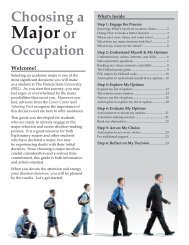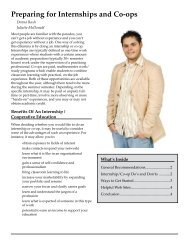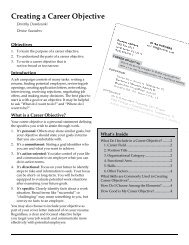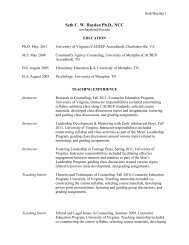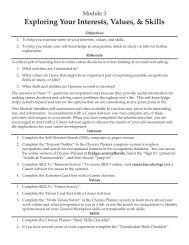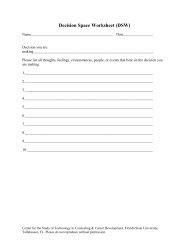Holland's Theory in a Post-Modern World: - The Career Center ...
Holland's Theory in a Post-Modern World: - The Career Center ...
Holland's Theory in a Post-Modern World: - The Career Center ...
Create successful ePaper yourself
Turn your PDF publications into a flip-book with our unique Google optimized e-Paper software.
Holland’s <strong><strong>The</strong>ory</strong> 241995), to demonstrate both l<strong>in</strong>guistic and metric equivalence to the SII. Additionally, Goh andYu (2001) stated that the same <strong>in</strong>ferences could be drawn from the SII-Ch<strong>in</strong>ese as from the SII.<strong>The</strong> Vocational Preference Inventory (VPI; Holland, 1985) was orig<strong>in</strong>ally developed foruse <strong>in</strong> the United States. <strong>The</strong> VPI consists of 291 items, <strong>in</strong>clud<strong>in</strong>g 160 occupations represent<strong>in</strong>geach of the six Holland’s themes <strong>in</strong> addition to five other scales (i.e., Self-Control, Mascul<strong>in</strong>ity-Fem<strong>in</strong><strong>in</strong>ity, Status, Infrequency, and Acquiescence). <strong>The</strong> VPI has been shown to have an <strong>in</strong>ternalconsistency score rang<strong>in</strong>g from .81 to .91 with an average of .88. <strong>The</strong> VPI has been translated<strong>in</strong>to more than 20 languages, and many of these are listed <strong>in</strong> Table 2.Leong et al. (1998) used an adapted version of the VPI to exam<strong>in</strong>e the validity ofHolland’s theory <strong>in</strong> a sample of 172 workers <strong>in</strong> India (60% men and 40% women; age range 22to 63). Three new response types were added to determ<strong>in</strong>e l<strong>in</strong>guistic and conceptual equivalence<strong>in</strong> India. In addition to “<strong>in</strong>terest<strong>in</strong>g/appeals to you” and “un<strong>in</strong>terest<strong>in</strong>g/dislike it,” “do notunderstand what it means,” “does not exists <strong>in</strong> India,” and “too low status to consider” wereadded. Utiliz<strong>in</strong>g the edited response choices with the English version of the VPI, Leong et al.found the <strong>in</strong>ternal consistency and the relation between RIASEC types to be adequate and similarto a US sample. <strong>The</strong> applicability of the VPI <strong>in</strong> India was complicated by f<strong>in</strong>d<strong>in</strong>gs with regardsto the secondary constructs. Congruence, consistency, and differentiation were not found to becorrelated with job satisfaction <strong>in</strong> this sample as is theorized by Holland (1997). <strong>The</strong> researchersemphasize the need for further research on the applicability of career assessments with thissample and the importance of cont<strong>in</strong>u<strong>in</strong>g to account for more culture-based variables such as theabsence of some occupations <strong>in</strong> certa<strong>in</strong> environments.Overall, we found that measures varied <strong>in</strong> the degree to which they were translated (i.e.,degree to which they took <strong>in</strong>to account cultural relevance). Several studies found that alterations




